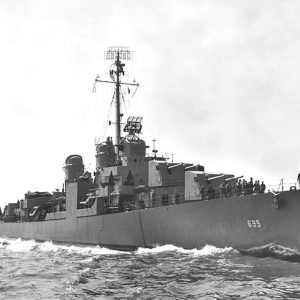calsfoundation@cals.org
USS Cooper (DD-695)
The USS Cooper was a U.S. Navy destroyer in World War II named for Monticello (Drew County) native Elmer Glenn Cooper. The Cooper sank on December 3, 1944, after being struck by a torpedo during a surface engagement at Ormoc Bay.
Elmer Glenn Cooper was born on May 9, 1905, in Monticello, to the farming family of James O. Cooper and Anna B. Cooper. He married Francis Vivian Lewis Sigmon in 1928. Cooper attended the U.S. Naval Academy in Annapolis, Maryland, graduating 476th in a class of 579 in 1927, and was retained for aviation instruction that summer. Cooper became a U.S. Navy pilot and was serving on the aircraft Carrier USS Langley when, during fleet maneuvers off southern California, he was aboard one of two seaplanes that collided in mid-air on February 2, 1938, killing nine men. His body was lost at sea.
The Monticello native was selected to have a DD-695 ship named after him. The USS Cooper’s keel was laid on August 30, 1943, at the Federal Shipbuilding and Drydock Co. at Kearney, New Jersey, and Cooper’s widow christened the ship with a bottle of champagne on February 9, 1944. The Cooper weighed 2,200 tons, was 376 feet and six inches long and forty feet and ten inches wide, and could reach speeds exceeding 35 knots. It was armed with six 5-inch 38-caliber guns, ten 21-inch quintuple-mount torpedo tubes, and 40-mm antiaircraft batteries. The vessel was commissioned on March 27, 1944, under Commander J. W. Schmidt.
The Cooper arrived at Pearl Harbor on September 4, 1944, with Commander Mell A. Peterson assuming command. The destroyer served with the Third Fleet and was involved in minor operations, including the rescue of a downed pilot twenty miles from Luzon in the Philippines.
On November 29, the USS Cooper joined the Seventh Fleet and, three days later, was ordered to move against Ormoc Bay with the destroyers USS Allen M. Sumner and USS Moale. They encountered enemy aircraft on the evening of December 2, and the Cooper shot one down. Spying a Japanese destroyer carrying troops, the Cooper opened fire along with the other vessels, destroying the enemy ship. The Cooper had opened fire on a second Japanese ship when it was hit on the starboard side by a Japanese torpedo. Still firing, the Cooper heeled over on its side and broke in half and sank in less than a minute. The surviving crewmen were in the water for fifteen hours before navy seaplanes arrived to rescue them, hindered by heavy enemy fire. Of the crew of 359 men, 191 died.
Commander Peterson later wrote: “The personnel performance was magnificent and the U.S.S. COOPER went down fighting. The calmness and coolness exhibited by all hands was exemplary. From the time of the hit until the ship had disappeared in less than one minute, the commanding officer noted no confusion and heard not a cry.”
In 2005, scuba diver Robert Lalumiere of Lebanon, New Hampshire, dove a record 633 feet to place a memorial plaque on the wreck of the USS Cooper. The feat was the subject of a 2006 documentary film, USS Cooper: Return to Ormoc Bay.
For additional information:
“Cooper.” Dictionary of American Fighting Ships. https://www.history.navy.mil/research/histories/ship-histories/danfs/c/cooper.html (accessed March 2, 2018).
“USS Cooper: Return to Ormoc Bay.” Internet Movie Database. http://www.imdb.com/title/tt0933397/ (accessed March 2, 2018).
Wilde, E. Andrew Jr., ed. The U.S.S. Cooper (DD-695) in World War II: Documents, Photographs and Survivors’ Interviews. Needham, MA: 2007. Online at http://destroyerhistory.org/assets/pdf/wilde/695cooper_wilde.pdf (accessed March 2, 2018).
Mark K. Christ
Little Rock, Arkansas
 Military
Military World War II through the Faubus Era, 1941 through 1967
World War II through the Faubus Era, 1941 through 1967 USS Cooper
USS Cooper  USS Cooper, ca. 1944
USS Cooper, ca. 1944 




Comments
No comments on this entry yet.